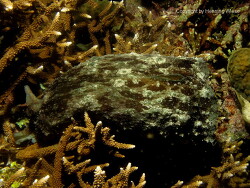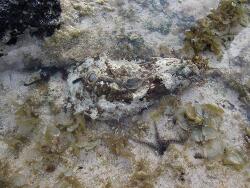Info
Dolabella auricularia (Lightfoot, 1786)
Dolabella auricularia is a sea hare with a slightly different body shape than Aplysia species. In Dolabella, the posterior end of the body is a sloping, disc-like shield with papillae along the edge and a large exhalation siphon in the middle. Buried in the tissue of this "dorsal shield" is a large, flattened, rather heavily calcified shell. In the midline in front of the shield is a smaller groove containing the inhalation siphon, which draws water into the almost completely enclosed mantle cavity.
The coloration of this lumpfish varies from specimen to specimen and can range from light brown, purplish brown, to various shades of green, olive green, to almost black, but is always said to be mottled. This lumpfish may have soft pustules that result in a more button-like appearance. The nature of its diet and habitat strongly influence its coloration, so it is always well camouflaged in its habitat.
Its extensive diet includes red, green and brown algae and various sea grasses. The lumpfish is nocturnal. Although the lumpfish is known to be a shallow water species, there is recent scientific evidence from the Gulf of Mannar at a depth of 50m (using a drift net in a traditional fishing vessel).
Dolabella auricularia is found in the Indian Ocean and the western and northwestern Pacific. It is also present in the Philippines, reportedly eaten by the local population there. If these sea hares are bycatch in fisheries they are processed into animal feed (fish feed, poultry feed).
Usually Dolabella auricularia is found in sheltered bays or lagoons, seagrass beds, on sand or mud and in large tide pools. Sometimes it is only recognized when it releases its reddish-purple "ink".
This species is said (according to Seaslugsforum) to reach a length of about 12cm, but a scientific study from 2014 gives a proven size of 20-40cm.
The scientifically proven lifespan is 16 months!
The lumpfish is interesting for the pharmaceutical industry and is the subject of numerous researches. It has anti-cancer, anti-tumor and anti-viral compounds.
Dolabella auricularia is the most common species found in the trade. Caution when introducing or changing water or transferring to another aquarium - Like all sea hares (nudibranchs), adjustment to density must be done very slowly and carefully, as they are very density sensitive. Socialization with shrimp is not advisable, as the shrimp may disturb the sea hare in its work or possibly consider it as food.
Host of Anthessius dolabellae(ectoparasitic copepod).
Synonymised names:
Aplysia ecaudata Rang, 1828
Aplysia gigas Rang, 1828
Aplysia hasselti Férussac in Rang, 1828
Aplysia teremidi Rang, 1828
Aplysia truncata Rang, 1828
Dolabella andersoni Allan, 1941
Dolabella callosa Lamarck, 1801
Dolabella cheni W. K. C. Sun, 1960
Dolabella ecaudata (Rang, 1828)
Dolabella gigas (Rang, 1828)
Dolabella hasselti Férussac in Rang, 1828
Dolabella rumphii Cuvier, 1817
Dolabella rumphii var. maculosa Bergh, 1905
Dolabella scapula O'Donoghue, 1929 (non-binominal)
Dolabella variegata Pease, 1860
Patella auricularia Lightfoot, 1786 (original combination)
Patella scapula Martyn, 1786 (non-binominal)
Sea hares feed on algae. They eat various types of algae, kelp and seaweed. In the process, plant parts are rasped off with the rasping tongue (radula). Microscopic food particles are also ingested with the algae. They are often used in aquaristics for algae problems, but with the end of their food they also get nutritional problems.
For protection against predators there are some species that additionally store the toxin aplysiatoxin. This aplysiatoxin is a product of cyanobacteria, which grow on certain types of seaweed. These are ingested along with the algae.
Sea hares are good algae eaters after a usually difficult acclimation period and are also not very picky about the algae. When acclimating, be sure to use the droplet method, as they are extremely sensitive to density fluctuations.
Thus, in addition to the usual filamentous algae, Wrangelia argus and so-called smear algae are often not spurned.
If no more algae are present, then it does not take long and the ea hare starves to death.
However, you can also offer it over-scalded lettuce as a substitute food, but then you should also looka for a substitute home.
Attention, important:
If you want to keep a sea hare, be sure to provide shelter so they don't get caught in a flow pump and shredded.
Dying sea hares are capable of causing the entire fish and crustacean population to die within a short period of time.
If the dead sea hare is not discovered in time, it is imperative to perform a very generous water change and additionally filter with charcoal to filter out the released toxins
Dolabella auricularia is a sea hare with a slightly different body shape than Aplysia species. In Dolabella, the posterior end of the body is a sloping, disc-like shield with papillae along the edge and a large exhalation siphon in the middle. Buried in the tissue of this "dorsal shield" is a large, flattened, rather heavily calcified shell. In the midline in front of the shield is a smaller groove containing the inhalation siphon, which draws water into the almost completely enclosed mantle cavity.
The coloration of this lumpfish varies from specimen to specimen and can range from light brown, purplish brown, to various shades of green, olive green, to almost black, but is always said to be mottled. This lumpfish may have soft pustules that result in a more button-like appearance. The nature of its diet and habitat strongly influence its coloration, so it is always well camouflaged in its habitat.
Its extensive diet includes red, green and brown algae and various sea grasses. The lumpfish is nocturnal. Although the lumpfish is known to be a shallow water species, there is recent scientific evidence from the Gulf of Mannar at a depth of 50m (using a drift net in a traditional fishing vessel).
Dolabella auricularia is found in the Indian Ocean and the western and northwestern Pacific. It is also present in the Philippines, reportedly eaten by the local population there. If these sea hares are bycatch in fisheries they are processed into animal feed (fish feed, poultry feed).
Usually Dolabella auricularia is found in sheltered bays or lagoons, seagrass beds, on sand or mud and in large tide pools. Sometimes it is only recognized when it releases its reddish-purple "ink".
This species is said (according to Seaslugsforum) to reach a length of about 12cm, but a scientific study from 2014 gives a proven size of 20-40cm.
The scientifically proven lifespan is 16 months!
The lumpfish is interesting for the pharmaceutical industry and is the subject of numerous researches. It has anti-cancer, anti-tumor and anti-viral compounds.
Dolabella auricularia is the most common species found in the trade. Caution when introducing or changing water or transferring to another aquarium - Like all sea hares (nudibranchs), adjustment to density must be done very slowly and carefully, as they are very density sensitive. Socialization with shrimp is not advisable, as the shrimp may disturb the sea hare in its work or possibly consider it as food.
Host of Anthessius dolabellae(ectoparasitic copepod).
Synonymised names:
Aplysia ecaudata Rang, 1828
Aplysia gigas Rang, 1828
Aplysia hasselti Férussac in Rang, 1828
Aplysia teremidi Rang, 1828
Aplysia truncata Rang, 1828
Dolabella andersoni Allan, 1941
Dolabella callosa Lamarck, 1801
Dolabella cheni W. K. C. Sun, 1960
Dolabella ecaudata (Rang, 1828)
Dolabella gigas (Rang, 1828)
Dolabella hasselti Férussac in Rang, 1828
Dolabella rumphii Cuvier, 1817
Dolabella rumphii var. maculosa Bergh, 1905
Dolabella scapula O'Donoghue, 1929 (non-binominal)
Dolabella variegata Pease, 1860
Patella auricularia Lightfoot, 1786 (original combination)
Patella scapula Martyn, 1786 (non-binominal)
Sea hares feed on algae. They eat various types of algae, kelp and seaweed. In the process, plant parts are rasped off with the rasping tongue (radula). Microscopic food particles are also ingested with the algae. They are often used in aquaristics for algae problems, but with the end of their food they also get nutritional problems.
For protection against predators there are some species that additionally store the toxin aplysiatoxin. This aplysiatoxin is a product of cyanobacteria, which grow on certain types of seaweed. These are ingested along with the algae.
Sea hares are good algae eaters after a usually difficult acclimation period and are also not very picky about the algae. When acclimating, be sure to use the droplet method, as they are extremely sensitive to density fluctuations.
Thus, in addition to the usual filamentous algae, Wrangelia argus and so-called smear algae are often not spurned.
If no more algae are present, then it does not take long and the ea hare starves to death.
However, you can also offer it over-scalded lettuce as a substitute food, but then you should also looka for a substitute home.
Attention, important:
If you want to keep a sea hare, be sure to provide shelter so they don't get caught in a flow pump and shredded.
Dying sea hares are capable of causing the entire fish and crustacean population to die within a short period of time.
If the dead sea hare is not discovered in time, it is imperative to perform a very generous water change and additionally filter with charcoal to filter out the released toxins







 KathiWeidinger
KathiWeidinger



















